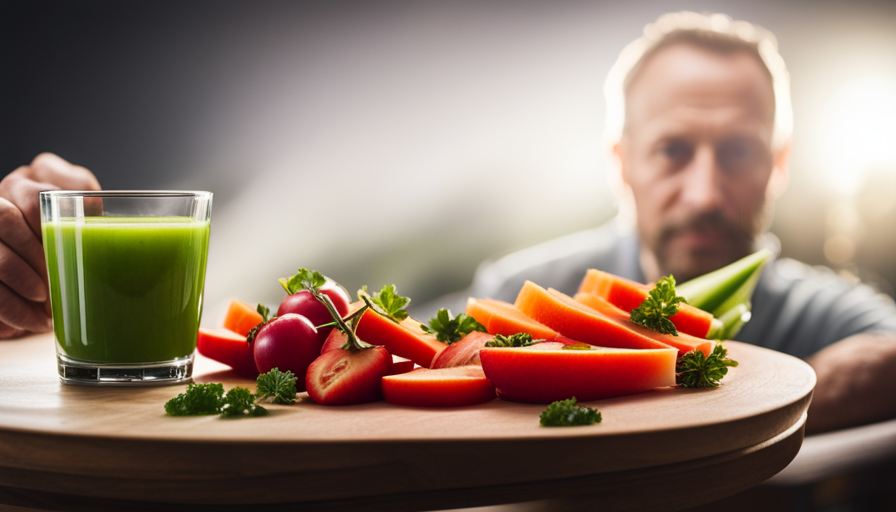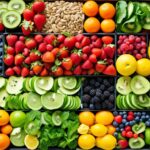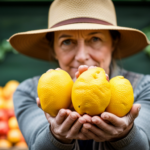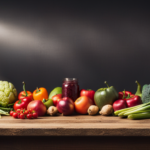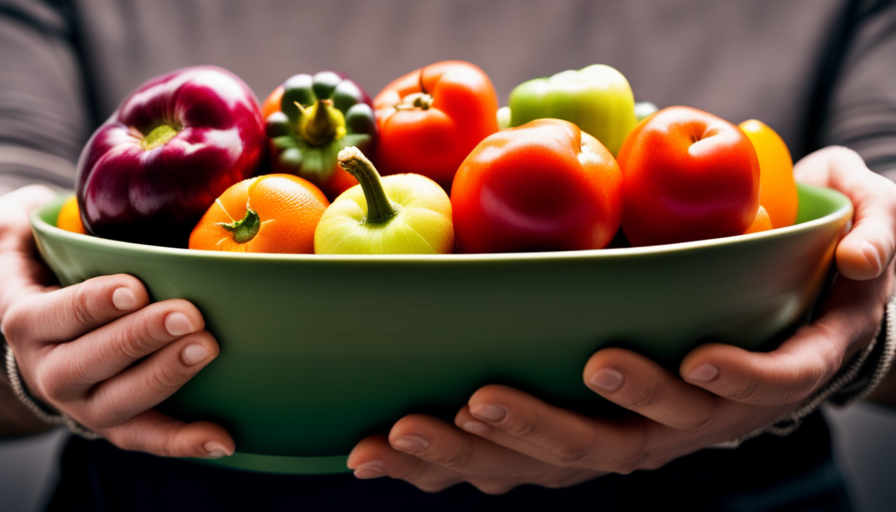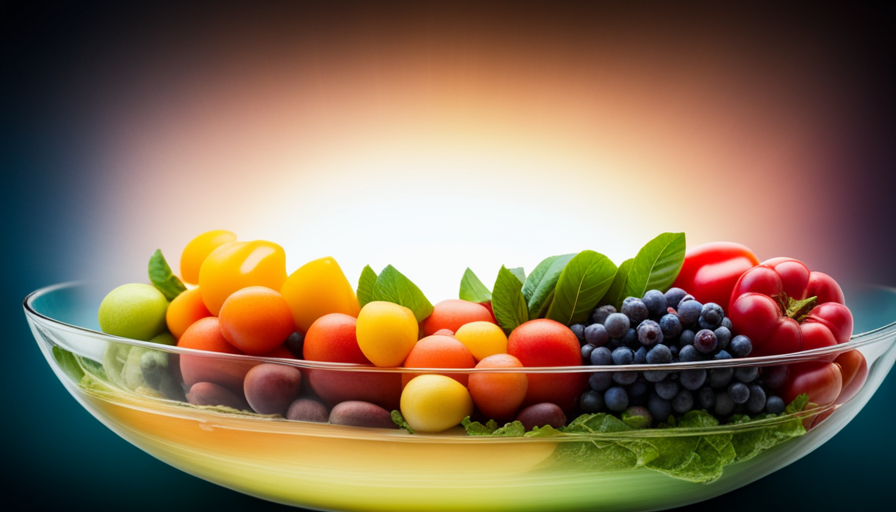Hello everyone! I am an expert in raw food diets, and today, I am here to discuss the amazing benefits of starting a raw food detox.
You may have heard of them before, but you might not know just how powerful they can be in helping us become healthier and happier versions of ourselves.
Before we dive into what it looks like to do one of these cleanses, let’s take a look at why they’re so beneficial and what changes you can expect to see after completing one.
What Is A Raw Food Cleanse?
A raw food cleanse is a great way to give your body some extra love and support. It’s an opportunity to reset, get back in touch with what we really need nutritionally, and detoxify our systems.
A raw food cleanse typically involves eating only foods that are uncooked or unprocessed for a period of time — usually between 3-7 days — and focusing on consuming nutrient-dense, plant-based sources such as fruits, vegetables, nuts, seeds, legumes and sprouted grains. Cleanses also involve eliminating certain things from the diet like refined sugars, processed foods, dairy products and alcohol.
By cutting out these items we can more easily focus on nourishing ourselves with real whole foods that provide us with energy and nutrients so that our bodies can function optimally. This type of lifestyle shift will have amazing effects on both physical health and mental well-being!
By taking part in this kind of cleansing process it’s possible to feel lighter mentally and physically while also having an increased sense of clarity, improved digestion and better overall wellbeing. With these positive changes comes a greater understanding of how different foods affect our body – which is key if you want to maintain optimal health long-term!
Moving onto the benefits of doing a raw food cleanse…
Benefits Of Doing A Raw Food Cleanse
Starting a raw food cleanse can be an exciting and intimidating experience. Imagine the vibrant colors of raw fruits, veggies, nuts, seeds and legumes that you’ll incorporate into your diet! Not to mention the changes in how you feel after taking on this lifestyle change.
Here are some of the benefits that come with maintaining a long-term raw vegan diet:
- Increased energy levels
- Improved digestion & overall gut health
- Balanced hormones & increased mental clarity
- Better skin complexion & hair quality
As a nutritionist specializing in raw foods, I understand first hand what it takes to get started on a journey towards better physical and mental health through plant-based living. A successful transition from cooked to uncooked meals involves commitment and dedication; however, once your body is used to these new dietary habits, the end result will be worth every bit of effort put in.
Eating only fresh plants provide us with essential vitamins and minerals necessary for healthy bodies as well as detoxifying properties which help rid our bodies of toxins while fostering internal balance. With all those nourishing elements combined with improved metabolism due to digesting less processed foods, your body will have all the right ingredients it needs for optimal performance.
By taking full advantage of everything nature has blessed us with, by eating various types of wholefoods within their natural state – such as leafy greens, colorful vegetables and antioxidant rich fruits – you’ll quickly start seeing drastic improvements in both short-term results like reduced bloating or clearer skin but also more profound long-term effects like higher energy levels throughout day and stronger immunity system.
Preparing for your cleanse means arming yourself with knowledge about proper nutrition which includes getting familiar with the different kinds of raw foods available so that you can properly fuel your body for success.
Pre-Cleanse Preparation
Before embarking on a raw food cleanse, it’s important to come prepared. Shopping strategies and planning ahead are key in achieving success during this process.
I always suggest my clients plan out their meals for the entire length of the cleanse before they even step foot inside the grocery store. This will ensure that you have all the necessary ingredients available so there’s no temptation to veer off track.
When shopping, stick with fresh produce like fruits, vegetables, nuts and seeds as these items make up the bulk of your daily intake while cleansing. You’ll also want to pick up some dried spices and seasonings which can add flavor without adding any extra calories or unhealthy fats.
Avoid processed foods at all costs – even if they’re labeled ‘raw’ or ‘vegan’ – as these products may contain hidden sugars or additives that could sabotage your efforts.
Once you’ve gathered all of your supplies, take some time to map out exactly what recipes you’d like to try each day of the cleanse. Having an established schedule takes away any guesswork when hunger strikes, allowing you to focus more on staying energized instead of hunting down snacks throughout the day.
With proper preparation and dedication, you’ll be ready to begin your journey into healthier living!
What To Expect During A Raw Food Cleanse
When it comes to raw food cleanses, I always tell my clients to expect improved clarity of thought, a physical detox, and a boost of natural energy.
On this kind of cleanse, you’ll be eating mostly plant-based foods that are unprocessed, uncooked and free of additives. This will help to give your body a break from unhealthy foods, and allow it to naturally purge built-up toxins.
You’ll also notice that your mental clarity will improve, as an abundance of fresh fruits and vegetables will provide your brain with the nutrients it needs to function optimally.
Plus, with a raw food diet, you’ll be getting plenty of natural energy to keep you going throughout the day.
So, if you’re ready to take the plunge and experience the benefits of a raw food cleanse, you know what to expect!
Mental Clarity
When embarking on a raw food cleanse, it’s important to be mindful of the mental clarity you may experience.
As someone who has been passionate about raw food nutrition for many years, I can tell you that there is often an immediate and lasting improvement in how we think and feel.
During this period of cleansing, focus on eating whole foods that are free from processed ingredients and additives.
Connect with your body through mindful eating – instead of emotional eating – as this will help you become more aware of what type of energy you’re putting into yourself.
This way, you’ll get the most out of your raw food diet by recognizing how particular foods make you feel both physically and mentally.
Instead of simply relying on willpower to stay motivated during the cleanse, connect with where you want to go emotionally so that your journey towards self-discovery becomes easier than ever before!
Physical Detox
In addition to the mental clarity experienced on a raw food cleanse, you can expect physical detoxification as well.
Eating whole foods that are free from additives and processed ingredients will help your body to naturally rid itself of toxins.
This process may involve some uncomfortable symptoms such as headaches or fatigue but it’s important to remember that these feelings are all part of the cleansing journey.
As much as possible, tune into the mind-body connection during this time so that you can feel more in touch with what is happening within your body while also engaging in emotional cleansing.
By being mindful of both aspects simultaneously, you’ll be able to get even deeper insight into yourself and reap greater rewards from your experience!
Energy Boost
As you go through your raw food cleanse, you can also expect to experience an energy boost. Eating nutrient-rich foods that are free of additives and processed ingredients will give your body the nourishment it needs to feel energized throughout the day.
By taking a mindful approach to eating and truly tuning into what your body is telling you, you’ll be able to maximize this benefit and make sure that each meal provides maximum nutritional value for optimal energy levels!
Not only will these changes in diet help with physical healing, but they can also aid emotional healing by giving yourself permission to take extra time for self-care.
Incorporating mindful eating into your routine can allow for greater connection with yourself which can lead to emotional clarity and overall wellbeing.
Through embracing healthier habits like this during a raw food cleanse, not only will your mental and physical health improve, but so too will your emotional well-being!
How To Eat During A Raw Food Cleanse
Now that you know what to expect during a raw food cleanse, let’s talk about how to eat during one. Eating a raw vegan diet is an excellent way to detoxify your body and nourish it with nutrient-dense foods. As far as restrictions go, the most important thing is to ensure that all of the foods consumed are uncooked or unprocessed. This means avoiding things like microwaving, frying, baking and boiling. Additionally, processed snacks and sugary drinks should be avoided as they have no nutritional value and can sabotage your efforts.
By using this method of eating, you will not only feel lighter but also more energetic! Raw diets typically contain high amounts of fruits and vegetables which provide fiber and essential vitamins and minerals needed for optimal health. Furthermore, focusing on plant-based proteins such as nuts, seeds, legumes and grains help maintain muscle mass while providing energy throughout the day.
Despite its benefits though, many people find themselves craving unhealthy comfort foods when beginning a raw dieting plan. Fortunately there are ways to satisfy cravings without compromising your commitment to becoming healthier! Some great alternatives include making smoothies instead of milkshakes or having hummus with vegetable sticks rather than fried chips. By replacing these bad habits with better options, you can still enjoy tasty treats while ensuring that your body gets the proper nutrition it needs!
Tips For Successful Cleansing
As a raw food nutritionist, I’m sure you know that cleansing is not just about the physical changes in your body but also about the mental and spiritual transformation. Having a positive mindset before, during and after your cleanse is key to its success.
When it comes to eating only raw foods while cleansing, remember to focus on the nutrient-dense options available. Here are some tips for successful cleansing:
-
Eat organic whenever possible
-
Focus on hydration with fresh vegetable juices or green smoothies
-
Incorporate superfoods like chia seeds and goji berries into your diet
-
Enjoy healthy fats from avocados, coconut oil and nuts/seeds
-
Make sure you’re getting enough protein through sprouted grains and legumes
Cleansing can be an incredibly rewarding experience if done with proper preparation and dedication. As long as you keep yourself focused on what you want to achieve from this journey – whether it’s weight loss or increased energy levels – it will give you the motivation needed stay consistent with your raw nutrition goals. With this approach, your cleanse will no doubt yield amazing results!
What To Drink During A Raw Food Cleanse
When embarking on a raw food cleanse, it’s important to stay hydrated. Drinking plenty of water throughout the day is essential for proper nutrition and mental clarity. However, there are other beverages you can enjoy while cleansing that will help support your body and nourish your cells.
Freshly-pressed juices made from organic vegetables and fruits are great sources of vitamins and minerals, as well as being naturally hydrating. A glass of celery juice in the morning or beetroot juice before bedtime are excellent choices for replenishing electrolytes.
Smoothies can also be beneficial when done right. For smoothie success, use fresh ingredients like banana or avocado with leafy greens such as kale or spinach. Add some almond milk or coconut yogurt for a creamy consistency then finish off with some berries for added sweetness and antioxidants. Remember though: if you’re looking to effectively detoxify and eliminate toxins from your body, stick to only pure fruit or vegetable-based drinks without any additional sweeteners – natural or otherwise!
Herbal teas are another great way to support your raw food cleanse journey by providing added nutrients and helping fight inflammation in the body. Try chamomile tea at night time to reduce stress levels, ginger tea mid-day for improved digestion, peppermint tea anytime during the day for calming energy boosts, and dandelion root tea first thing in the morning to kickstart liver detoxification processes.
Making smart beverage decisions during a raw food cleanse will keep you feeling energized yet relaxed all day long – setting up perfectly for avoiding tempting foods later on in this process.
Foods To Avoid During A Raw Food Cleanse
Now that we’ve discussed some of the best drinks to have during a raw food cleanse, let’s talk about which foods to avoid.
Paying attention to what you eat is key for any successful cleanse and it’s important to understand which foods are not beneficial when on a raw diet.
This includes avoiding processed snacks, fried or greasy foods, refined sugar, dairy products, white flour and other processed grains.
While these should be avoided all together, if you do need a snack there are plenty of delicious raw recipes available for alternatives such as nuts, fruits, sprouts and seeds.
Eating fresh vegetables can also provide your body with natural vitamins and minerals while keeping cravings away.
Interestingly enough, although raw diets typically contain predominantly plant-based ingredients they can still cause an imbalance in essential nutrients due to lack of variety in the diet.
A few examples include B12 deficiency caused by inadequate intake of animal proteins or Calcium deficiencies from low consumption of green leafy vegetables or bone broths.
It’s important to pay close attention to nutrient needs throughout the duration of the cleanse so these potential side effects don’t occur.
To help prevent this make sure you’re getting adequate amounts of different types of produce daily along with adding in herbs and spices for added flavor!
Potential Side Effects Of A Raw Food Cleanse
I’m often asked about the potential side effects of a raw food cleanse. Gastrointestinal upset, detox symptoms, and nutrient deficiencies are some of the most common issues I hear about.
It’s important to understand that these symptoms can arise from doing a raw food cleanse if you’re not careful and aware. So, I always recommend listening to your body, and being mindful of the nutrients you’re taking in.
That way, you can avoid any potential digestive discomfort, fatigue, and nutrient deficiencies.
I’m here to help, so if you have any questions, please don’t hesitate to reach out.
Gastrointestinal Upset
When it comes to raw food cleanses, gastrointestinal upset is a common side effect. Your gut microbiome can be thrown off balance due to the drastic change in diet, which leads to symptoms like nausea and diarrhea.
But don’t let this scare you away! The body naturally detoxifies itself everyday – a raw food cleanse just helps jump-start that process by providing more fiber for toxin removal and increasing beneficial bacteria in your gut microbiome.
To avoid distress while on a cleanse, start slow and gradually increase consumption of fruits and vegetables as you go along. This way, your body has time to adjust and won’t be overwhelmed with all the changes at once.
Remember, if done correctly, a raw food cleanse can do wonders for your overall health – so no need to worry about any unpleasantness!
Detox Symptoms
It’s easy to get excited about beginning a raw food cleanse – while it can have fantastic health benefits like improving digestion and mental clarity, there are some potential side effects you should be aware of.
One such symptom is detoxification, which occurs as your body begins to expel toxins from the foods you’re eliminating. These symptoms may include headaches, fatigue, nausea, or skin breakouts.
It’s important to remember that these temporary discomforts are all signs that your body is healing! With proper hydration and plenty of rest, most people find their detox symptoms start to subside after a few days.
In fact, many report feeling more emotionally balanced and having improved mental clarity once they complete their cleanse. You don’t need to worry – with time and patience this powerful process will naturally take its course for an overall healthier lifestyle!
Nutrient Deficiencies
It’s important to note that, while the detox symptoms of a raw food cleanse are temporary, there is another potential side effect you should be aware of – nutrient deficiencies. Eating an exclusively raw food diet can lead to inadequate levels of important vitamins and minerals if not monitored carefully.
This is why it’s so important to ensure your meals contain plenty of fresh, raw fruits and vegetables as well as other whole-food sources like nuts and seeds for adequate nutrition. Don’t forget sprouted grains and legumes, too!
With careful attention paid to all these different raw food sources, you’ll ensure your body has everything it needs throughout the cleanse. If you find yourself experiencing some common signs of nutritional deficiency such as fatigue or headaches alongside any initial detox symptoms, consider supplementing with multivitamins or even consulting a nutritionist who specializes in raw foods.
Taking proactive steps now will help keep your body healthy during this powerful process! After all, making sure you’re getting enough essential nutrients from natural sources will support long-term health benefits far beyond just the cleansing period itself.
Post-Cleanse Care
It’s like that moment when you drop a heavy bag off your shoulders after a long, hard journey. That is how it feels to complete a raw food cleanse: relieved and accomplished.
After the process of cleansing comes post-cleanse care; maintaining the mental balance and emotional clarity achieved during the cleanse.
Here are four ways to ensure that you continue on this new path towards health and wellness:
-
Incorporate yoga or meditation into your daily routine – Both activities help promote mindfulness, relaxation, and an overall sense of well-being.
-
Eat mindfully – Take time to enjoy every bite of food you eat instead of rushing through meals.
-
Get sufficient sleep – Allow yourself enough rest so your body can recover from any rigorous physical activity and heal itself.
-
Make time for self-care – Set aside at least one day out of the week for yourself where you practice something that brings pleasure such as going for a walk in nature, taking a hot bath, or reading a book in peace and quiet.
This post-cleanse care will serve as building blocks towards achieving optimal health and feeling rejuvenated with each passing day!
As we move forward from here, let us explore recipes for furthering our commitment to eating raw foods for nourishment and vitality…
Recipes For A Raw Food Cleanse
I’m a firm believer in the power of raw food cleanses. They can be an incredibly effective way to jumpstart your health and wellness journey, and it all starts with stocking up on the right ingredients and kitchen tools.
When you’re planning for a cleanse, there are certain key items that I recommend having on hand, such as organic fruits and vegetables, nuts, seeds, sprouted grains, sea vegetables, and natural sweeteners like stevia or honey. Having these staples will ensure that you’ll have plenty of nutrient-dense options available during your cleanse.
In addition to fresh produce, it’s also essential to have some basic kitchen equipment at your disposal so you can make tasty meals quickly. A blender is absolutely necessary for making smoothies and soups without any added sugar or preservatives. Other invaluable appliances include a spiralizer for zucchini noodles, a dehydrator for creating delicious raw snacks and crackers, and even a juicer if you want to get extra creative!
With these basics taken care of ahead of time, you should have no problem sticking to your raw food diet throughout the duration of your cleanse.
Afterward though? That’s when things really start getting interesting – let’s take a look at how to incorporate raw foods into your daily diet beyond just cleansing!
How To Incorporate Raw Foods Into Your Diet After A Cleanse
Now that you’ve completed your raw food cleanse, it’s time to transition back into a more sustainable lifestyle. The key is to incorporate the same principles of eating whole and unprocessed foods but in moderation. Here are some tips on how to make this change:
-
Focus on nutrient-dense foods like fruits, vegetables, nuts, seeds, legumes and sprouted grains as staples in your diet.
-
Practice mindful eating – savor every bite of your meal and don’t rush through meals or snacks; enjoy them!
-
Incorporate plant-based proteins such as tempeh, tofu and beans for added nutrition without overdoing animal products.
-
Drink plenty of fluids throughout the day including water and herbal tea so you stay hydrated (especially if exercising).
Making these simple changes can help you maintain a balanced raw nutrition routine while still enjoying treats occasionally. With these tips, you’ll be well on your way towards creating a long term healthy relationship with food based on a plant based diet that supports both physical and mental wellbeing.
Now let’s move onto discussing how to make this raw food cleanse sustainable in the long run…
How To Make A Raw Food Cleanse Sustainable
Ah, raw food cleanses. The latest fad to take over the wellness world. A surefire way of losing a few pounds and looking good for that beach vacation you’re about to go on – but only if you can stick with it!
Making a raw food cleanse sustainable is all about developing healthy habits that don’t require willpower or deprivation. That means meal planning should be your first priority. Planning ahead helps ensure meals are delicious, nutritious, and satisfying enough to keep hunger at bay while curbing cravings. Here’s a handy table of ideas:
| Meal | Snack Ideas | Recipes |
|---|---|---|
| Breakfast Smoothie Bowls | Nuts & Seeds | Acai Berry Bowl |
| Wraps/Salads | Dried Fruit & Veggies | Zucchini Pasta Salad |
| Soups | Green Juice/Smoothies | Roasted Carrot Soup |
| Sprouted Grain Toast & Avocado Spreads | Vegan Buddha Bowl |
Maintaining high energy levels throughout the day also plays an important role in making a raw food diet successful in the long-term. Start by minimizing refined sugar and processed foods from your daily routine and gradually increase physical activity as much as possible – this could include anything from walking up stairs instead of taking the elevator to yoga classes several times per week. In short, small changes add up quickly when it comes to forming sustainable habits!
With consistent effort and dedication, transitioning towards a more plant-based diet will not only improve overall health and well-being but also help nurture mindful eating practices that benefit our bodies far beyond just one cleanse period.
How To Get Back On Track After A Raw Food Cleanse
Now that you have finished your raw food cleanse, it’s important to get back on track in a mindful and sustainable way. This includes re-introducing other foods gradually while still incorporating healthy choices into your diet.
Here are 3 tips for getting back on track after a raw food cleanse:
-
Portion control – It is essential to be mindful of portion sizes when transitioning out of the cleanse. Eating too much can cause bloating or weight gain, so start off slowly with small portions and increase as needed.
-
Variety – A variety of fresh fruits, vegetables, legumes, nuts, seeds and sprouted grains should make up the majority of meals post-cleanse. Introduce cooked options such as grilled lean proteins and whole grain pasta once you feel comfortable doing so.
-
Nutrient density – Foods high in nutrient density such as leafy greens, cruciferous veggies (broccoli & cauliflower) and sweet potatoes will help support long term health benefits from the cleanse by providing vital vitamins and minerals to nourish your body going forward.
It’s also important to listen to your body during this transition phase; if certain foods don’t agree with you then take note and avoid them in future meals!
Now let’s look at how to best support your health during a raw food cleanse…
How To Support Your Health During A Raw Food Cleanse
A raw food cleanse can be a great way to support your health and wellness. But, it’s important that you take the time to set yourself up for success so that you can get the most out of this experience.
One of the most important things when engaging in a raw food diet is having proper emotional support throughout the process. Here are some tips I recommend following to ensure you have adequate emotional support during your cleanse:
First, make sure you surround yourself with people who will encourage and motivate you while on your journey. Having a supportive friend or family member by your side will help keep you motivated and remind you why starting this cleanse was such an important decision in the first place.
Additionally, join online forums or social media groups where others are also engaged in similar pursuits – here, you’ll find lots of helpful advice as well as compassionate conversation which could prove invaluable during times when it feels like progress isn’t happening quickly enough.
Finally, take time each day for self-care activities such as yoga, meditation or journaling. Focusing on taking care of yourself emotionally can really help boost morale and enthusiasm during moments when motivation starts waning.
By continuing to prioritize self-care even after completing your raw food cleanse, you can create lasting positive habits that will serve both your mental and physical health long term.
Frequently Asked Questions
What Is The Best Length Of Time For A Raw Food Cleanse?
When it comes to doing a raw food cleanse, the best length of time really depends on your individual needs and goals. As a nutritionist, I generally recommend anywhere from 3-7 days for optimal detox benefits, emotional clarity, and improved overall wellness.
During this time you’ll be eating only raw foods – fruits, vegetables, nuts, seeds – all without the use of cooking or processing.
It’s important that you listen to your body throughout the process and adjust accordingly; if at any point during the cleanse you feel overwhelmed or exhausted then take some extra rest!
How Do I Know If A Raw Food Cleanse Is Right For Me?
Making the decision to do a raw food cleanse is an important one, and it’s not right for everyone.
Before taking on this eating plan, ask yourself if you’re looking for physical or mental detox benefits?
If so, then you can start by slowly introducing more raw foods into your diet to see how your body responds.
Determine what works best for you and adjust accordingly.
Ultimately, you’ll be able to decide whether or not a raw food cleanse is right for you.
Are There Any Supplements That I Should Take During A Raw Food Cleanse?
When considering a raw food cleanse, it’s important to think about any supplements you may need. Taking the right supplements can boost your mental and emotional health during the cleanse, making for an easier transition.
Supplements like omega-3 fatty acids and probiotics are great for keeping energy levels up and improving gut health. B vitamins can help with stress management, while iron is essential to prevent fatigue.
Before starting a raw food cleanse be sure to consult with a nutritionist or healthcare professional who can recommend what type of supplements best suit your needs.
What Kind Of Exercise Should I Do While Doing A Raw Food Cleanse?
When embarking on a raw food cleanse, it’s important to remember the adage ‘a healthy body is a happy one’. Exercise should be an integral part of your eating habits and lifestyle adjustment.
It can help boost energy levels and improve overall health while aiding weight loss goals. As a nutritionist specializing in raw foods, I recommend moderate-intensity exercises such as walking, jogging or biking for 30 minutes each day.
This will provide you with the physical benefits of exercise without overwhelming yourself.
Is It Safe To Do A Raw Food Cleanse While Pregnant Or Nursing?
It’s important to make sure you’re making safe dietary changes while pregnant or nursing, and embarking on a raw food cleanse is no exception.
While eating a mostly raw diet of fruits and vegetables can be beneficial for both mother and child in terms of providing essential nutrients, it’s best to talk to your doctor before starting any sort of extreme dietary change during pregnancy or while nursing.
When done properly, following the guidance of a qualified nutritionist familiar with the raw diet, a raw food cleanse can provide numerous benefits to both mother and baby.
How Does Storing Raw Food at Sonic Affect the Results of a Raw Food Cleanse?
Storing raw food at sonic can negatively impact the results of a raw food cleanse. The high levels of heat and exposure to extended periods of time can cause the food to spoil and lose its nutritional value. It is important to store raw food in a cool, dark place to maintain its freshness and health benefits.
Can I Transition Back to Raw Food After Eating Cooked Food?
Transitioning back to raw food after eating cooked food can be done gradually. Start by incorporating more raw fruits and vegetables into your diet each day. Reintroduce raw nuts, seeds, and sprouted grains to ease the transition. Listen to your body’s response to the change and make adjustments accordingly.
Conclusion
The raw food cleanse can be a powerful tool to reset your body and jumpstart healthier eating habits. As you embark on this journey, it’s important to listen to your body and make sure that the length of time is right for you. Taking the necessary supplements, exercising in moderation, and being mindful of any safety concerns will help ensure that your experience is successful and truly transformative.
Imagine how amazing it feels after completing a raw food cleanse! The energy gained from eating whole foods without processing or added chemicals boosts vitality and provides an abundance of nourishment to every cell in your body.
You’ll look forward to maintaining these healthy habits so that you may continue feeling vibrant and alive with each passing day!

